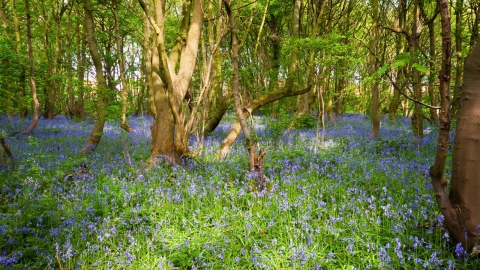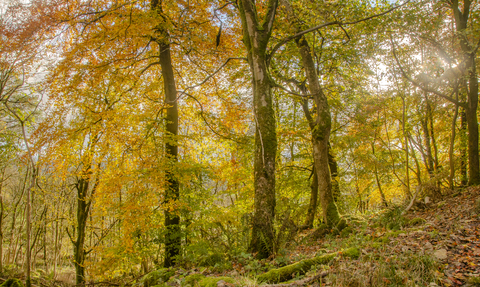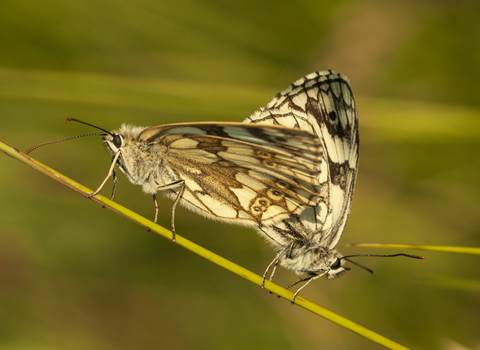
Hollinhurst Wood Nature Reserve
Treecreeper © Richard Scott 2019

Devil's-bit scabious © Keith Lynes
Hollinhurst Wood Nature Reserve
Location
Know before you go
Dogs
Please respect the resident wildlife and keep dogs on a short lead.
When to visit
Opening times
Open at all times. We recommend a 1 hour trip for this reserve but if you are looking for a longer outing why not combine with our other Lower Aire Valley reserves, the Lines Way walk, or RSPB St Aidan’s?Best time to visit
April to SeptemberAbout the reserve
September – the month that bridges summer and autumn, and a time of changing colours. The predominant colour in this month at Hollinhurst Wood is purple, as vast amounts of devil’s-bit scabious flower in the meadow. There’s purple aplenty in spring too, when bluebells flower in the woods, following on from the yellow of daffodils and white of snowdrops.
The meadow area is important for its combination of marshy, damp-loving plants and drier acid grassland species, more typically seen in our uplands. It’s home to a range of plant species that are still influenced by ‘ridge and furrow’ marks left by Medieval farmers, who grew food here and ploughed using an oxen-pulled plough. The damper soils in the furrows (troughs) support meadowsweet, wild angelica, devil's-bit scabious, common fleabane and sneezewort, while the drier conditions along the ridges attract sheep's sorrel, sheep's fescue, harebell and tormentil, among others. As well as the undulating pattern left by this ploughing, small craters are evidence of the area’s more recent coal-mining past.
Hollinhurst Wood is part of the Lower Aire Valley green corridor, where animals move between the different reserves and surrounding fields. Take an early morning stroll to look for foxes and deer passing through. In autumn, look for skeins of migrating pink footed geese flying in a ‘V’ shape overhead.
In the woodland, tree species include oak, birch, wych elm, hazel, crab apple, guelder rose and field maple, with willows in the damper areas. In autumn, the wood is an excellent place to spot fungi, including clouded funnel and wood blewit mushrooms.
Species
Contact us
About
The woodland and meadow are designated as a 'Site of Geological or Ecological Importance' for the range of plants present in the meadow and the woodland. The meadow area is important for its combination of marshy, damp loving plants and drier acid grassland species more typical of upland regions. Woodland species include oak, birch, wych elm, hazel, crab apple, guelder rose and field maple. Willow can be found in the damper areas, whilst hawthorn and blackthorn form the main components of an intermittent hedgerow which borders part of the site, creating an attractive habitat for birds.
In the spring a stunning array of bluebells can be seen throughout the woodland. The range of plant species supported by the meadow are still influenced by ridge and furrow marks left by Medieval farmers. The damper soils present within the furrows support a range of species which favour wetter soil and include meadowsweet, wild angelica, devil's-bit scabious, common fleabane and sneezewort. The drier conditions along the ridges attract plants such as sheep's sorrel, sheep's fescue, harebell and tormentil.
Hollinhurst Wood is part of the green corridor in the Lower Aire Valley in Leeds owned by Leeds City Council and managed in partnership with the Trust.
Seasonal highlights
- Spring: Plants - Wood anemone; Bluebells; Birds - Chiffchaff; Blackcap
- Summer: Plants - Devil's-bit scabious; Sneezewort; Harebells
- Autumn: Plants - Guelder rose; Crab apple
- Winter: Mammals - Wood mouse; Birds - Great spotted woodpecker; Treecreeper
History
The name Hollinhurst Wood comes from the word 'hollin' which refers to the abundance of holly trees in the area. Hollies were often planted as a supply of winter feed for livestock.
In medieval times the meadow area was used for growing food and ploughed using an oxen-pulled plough. You can see the undulating broad ridge and furrow pattern left behind from ploughing. Evidence of past coal extraction is visible in the form of small craters left throughout the woodland and meadow.
Directions
Public transport
Nearest train station is at Woodlesford, 3 miles from Hollinhurst Wood. Buses run from Leeds Rail Station to Leeds Road in Great Preston, a short walk away from the woods.
By car
From the north, leave the M1 South at Junction 46 onto the A63 (Selby Road). Take the second right onto the A642 (Wakefield Road), then a left in Swillington onto Astley Lane. Carry on this road for just over a mile until you reach Wood Lane on your left. Park in the lay by at the side of the road.
Did you know?
The name Hollinhurst Wood comes from the word 'hollin', which refers to the abundance of holly trees in the area. Hollies were often planted to supply winter feed for livestock.

The autumn colours were even more beautiful when the sun came out
Photo Credit - Telling our Story Volunteer, Sara



